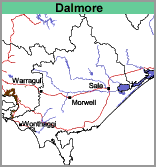Dalmore (Da)
The normal type of Dalmore Clay mapping unit does not occur in the West Gippsland region - but just outside it in the Bass River valley area. All occurrences in this region are either Dalmore clay, non-peaty (Da,np) or Dalmore clay, heavy surface (Da,hs) both of which are not separated at this mapping scale. For further information regarding this mapping unit refer to Dalmore clay in the adjoining Port Phillip and Westernport Region.
| Dalmore, heavy surface (Da,hs) Geology Recent lacustrine (lake or swamp) deposits. Landform Lacustrine plain. Soils |  |
Land Use
Dalmore, heavy surface is generally used for pasture production. When dry the soil cracks deeply but when wet the soil swells and water infiltration is relatively slow. Excessive surface water is often a problem during the wetter months.
Dalmore clay, non-peaty (Da,np)
Geology
Recent lacustrine (lake or swamp) deposits.
Landform
Lacustrine plain.
Soils
The Dalmore, non-peaty, has a black friable clay surface soil to about 200 mm depth. This overlies black or dark grey plastic heavy clays which may become paler in colour and mottled with yellow-brown, with depth. At about l metre depth, mottled grey and yellow-brown heavy clays usually occur which continue to at least 1.8 metres.
Land Use
The non-peaty soil is considered inferior to the peaty soil (Dalmore Clay, found in the Koo Wee Rup region) as it lacks the peaty deeper subsoil. In the past it was not commonly used for vegetables and mostly carried pasture. However, there has been an increasing trend towards using this soil for vegetables and floriculture.


